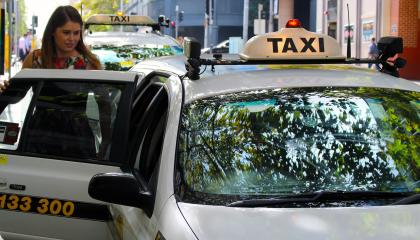Specific safety standards apply to
It is a condition of
Information on this page is specific to passenger services which are booked (not rank and hail in a taxi). Information about safety standards for taxis can be found here.
Which safety standards apply to booked services?
All five categories of safety standards apply to booked services:
- Safety Management System
- Vehicle standards
- Insurance
- Provision of information
- Drivers
Safety Management System
A booking service provider must have a
Vehicle standards
The owner of a vehicle used to provide a booked passenger service has a specific obligation to ensure the vehicle is appropriately registered and safe to be driven on the road (roadworthy).
All vehicles must undergo annual safety checks — previously called a pink slip — even if they are less than five years old.
The provider of the booking service is responsible for ensuring this safety standard is met.
Maintenance and repairs
The owner of the vehicle used to provide a booked service has specific obligation to ensure:
- the vehicle is regularly and properly maintained (consistent with the manufacturer’s recommendations)
- maintenance or repairs are carried out by a licenced mechanic; and
- records of maintenance and repairs are kept.
Basic maintenance does not need to be carried out by a licenced mechanic.
Basic maintenance includes:
- adding approved oils or other fluids to engines, transmissions, differentials, power steering reservoirs, windscreen washer reservoirs, master cylinders, radiators or batteries,
- changing engine, transmission or differential oils,
- changing engine oil filters or fuel filters,
- carrying out general lubrication,
- changing spark plugs,
- changing wheels or tyres,
- changing light bulbs,
- replacing or repairing seats or floor coverings,
- repairs to the interior of the vehicle that do not affect the safe operation of the vehicle,
- replacing external rear vision mirrors
The provider of the booking service is responsible for ensuring this safety standard is met.
Wheelchair accessible vehicles (and drivers)
The provider of the booking service and owner of the vehicle has a specific obligation to ensure that a vehicle used to provide a wheelchair accessible service:
- meets specific Australian Standards for hoists, tie downs and ramps for wheelchair accessible vehicles
- has a space where a wheelchair is carried inside a vehicle at least 1300mm long, 800mm wide and 1500mm high, with no intrusions other than adjustable restraint devices, for each wheelchair carried
- carries an appropriate number of wheelchair restraints
- complies with the Disability Standards for Accessible Public Transport
- is supplied with an approved child restraint
The booking service provider must ensure the driver of a wheelchair accessible vehicle is competent in loading, unloading and transporting wheelchair passengers.
Signs and markings*
The driver of a vehicle providing booked passenger services must ensure that a retroreflective sign is displayed or attached to the vehicle that:
- makes it clear the vehicle is carrying out a booked service
- is clearly visible from the outside of the vehicle, and
- is located on or near the rear of the driver’s side of the vehicle.
All vehicles providing passenger services that are not taxis must not have any signs, lights or markings that would lead someone to believe the vehicle is a taxi plying or standing for hire (providing rank or hail services).
*This does not apply to taxis used to provide booked services. See Safety standards for taxis.
The provider of the booking service is responsible for ensuring drivers comply with these safety standards.
Motorcycles
The provider of a booking service and the owner of the motorcycle must ensure that only the following motorcycles are used for passenger services and that they meet the Australian Design Rules and are fitted with wheel guards:
- LC (motorcycles)
- LD (motorcycles with sidecar)
- LE (three-wheelers).
Only LD and LE motorcycles may be used on unsealed roads.
LC motorcycles must have a minimum engine capacity of 500cc and cannot have a two-stroke engine.
The provider of a booking service is responsible for ensuring that the following equipment is made available, in an undamaged condition and a range of sizes for the use by the prospective passengers of a motorcycle used to provide a passenger service:
(a) motorcycle helmet that complies with rule 270 (3) of the Road Rules 2014
(b) riding gloves,
(c) protective jacket,
(d) boots or gaiters.
The provider of a booking service must ensure the driver of a motorcycle that is being used to provide a passenger service is competent in the operation of the motorcycle while carrying a passenger.
Insurance
The owner of a vehicle used for a booked service has a specific obligation to ensure that each vehicle used to provide a passenger service is covered by a valid insurance policy for third party property damage with cover of at least $5 million.
The provider of the
Third party property insurance covers for damage caused to other people’s vehicles or property arising out of an accident.
This differs from CTP Green Slip Insurance which covers liability for injuries caused to others in an accident but does not cover damage to third-party property. The third party property insurance needs to be purchased separately.
All insurance must provide continuous coverage. This means that there are no days between policies in which a vehicle provides a passenger service while it is not insured.
Any insurance policy must be issued by a corporation authorised under the Insurance Act 1973 (Cth).
Provision of information
The provider of a booking service has a specific obligation to make information available to the person who booked the service about the hire vehicle that has been booked and about the driver of the vehicle.
The information must be sufficient to enable the proposed passenger to identify the vehicle and the driver.
If the booking is made for a wheelchair accessible vehicle, the proposed passenger must be notified of the estimated time of arrival at the nominated collection point within a reasonable time before that arrival.
Drivers
The provider of the booking service (as well as the provider of the taxi service, facilitator and affiliated provider (if relevant)) are responsible for ensuring that a person does not drive a hire vehicle if:
- the person has been found guilty of a
disqualifying offence for a driver; or - the person has not held an unrestricted Australian driver licence for a total of at least 12 months in the preceding four years (and continues to hold such a licence); or
- the person does not meet the medical standards for commercial vehicle drivers set out in the publication Assessing Fitness to Drive (as amended from time to time).
A person must also not drive a hire vehicle if the person last held a driver authority under the Passenger Transport Act 1990 or the Passenger Transport Act 2014 that was cancelled (other than on medical grounds) or if the person’s most recent application for a driver authority under either of those Acts was rejected (within the preceding 10 years) on the grounds that the person was not considered to be of good repute and in all other respects a fit and proper person.
You should read the Driver page for more information about safety standards applicable to drivers of hire vehicles.


